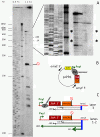Transcriptional analysis of ftsZ within the dcw cluster in Bacillus mycoides
- PMID: 23384289
- PMCID: PMC3762067
- DOI: 10.1186/1471-2180-13-27
Transcriptional analysis of ftsZ within the dcw cluster in Bacillus mycoides
Abstract
Background: In Bacillus mycoides, as well as in other members of the B. cereus group, the tubulin-like protein of the division septum FtsZ is encoded by the distal gene of the cluster division and cell wall (dcw). Along the cluster the genes coding for structural proteins of the division apparatus are intermingled with those coding for enzymes of peptidoglycan biosynthesis, raising the possibility that genes with this different function might be coexpressed. Transcription of ftsZ in two model bacteria had been reported to differ: in B. subtilis, the ftsZ gene was found transcribed as a bigenic mRNA in the AZ operon; in E. coli, the transcripts of ftsZ were monogenic, expressed by specific promoters. Here we analyzed the size and the initiation sites of RNAs transcribed from ftsZ and from other cluster genes in two B. mycoides strains, DX and SIN, characterized by colonies of different chirality and density, to explore the correlation of the different morphotypes with transcription of the dcw genes.
Results: In both strains, during vegetative growth, the ftsZ-specific RNAs were composed mainly of ftsZ, ftsA-ftsZ and ftsQ-ftsA-ftsZ transcripts. A low number of RNA molecules included the sequences of the upstream murG and murB genes, which are involved in peptidoglycan synthesis. No cotranscription was detected between ftsZ and the downstream genes of the SpoIIG cluster. The monogenic ftsZ RNA was found in both strains, with the main initiation site located inside the ftsA coding sequence. To confirm the promoter property of the site, a B. mycoides construct carrying the ftsA region in front of the shortened ftsZ gene was inserted into the AmyE locus of B. subtilis 168. The promoter site in the ftsA region was recognized in the heterologous cellular context and expressed as in B. mycoides.
Conclusions: The DX and SIN strains of B. mycoides display very similar RNA transcription specificity. The ftsZ messenger RNA can be found either as an independent transcript or expressed together with ftsA and ftsQ and, in low amounts, with genes that are specific to peptidoglycan biosynthesis.
Figures





References
-
- Gause GF. Some physiological properties of dextral and of sinistral forms in Bacillus mycoides flügge. Biol Bull Woods Hole MA. 1939;76:448–465. doi: 10.2307/1537751. - DOI
Publication types
MeSH terms
Substances
Associated data
- Actions
- Actions
LinkOut - more resources
Full Text Sources
Other Literature Sources
Molecular Biology Databases

